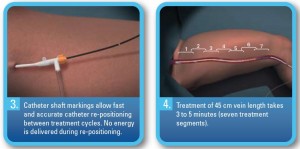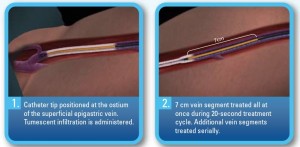VNUS Closure – Venefit
Radiofrequency Ablation for Varicose veins (RFA)
What is RFA?
Radiofrequency ablation is the name for a modern technique to remove varicose veins. Electrical energy is used to heat the vein in order to destroy it.
How does it work?
A fine tube (catheter) is passed through the skin near the knee and then threaded up the diseased long saphenous vein. The catheter is attached to a power unit that heats up the end of the catheter. The heat seals the walls of the vein so that no blood can flow through it. The operation can be done under general or local anaesthetic.
How is RFA different to standard surgery?
Standard surgery usually requires a cut in the groin to tie off the vein, after which it is removed by a stripping device. This can cause significant bruising. RFA avoids the need for a cut in the groin and there is minimal bruising so people who have RFA can usually return to normal activity sooner than those who have standard treatment.
Is RFA better than standard surgery?
The main advantage of RFA is that after the operation there is very little discomfort and bruising compared to conventional surgery. In the long term an excellent cosmetic outcome can be expected from either technique. There is a similar risk of recurrence following either procedure.
Is everyone with varicose veins able to have RFA?
No. Some people have large, winding veins that are not suitable. Recurrent varicose veins after previous surgery are often unsuitable for RFA. We will be happy to discuss whether your veins are suitable for RFA. About 70% of people with varicose veins can be treated with RFA.
Is RFA all I need for my veins?
RFA (VNUS) will remove the major superficial veins, including the saphenouss. It is, however, usually necessary to have the bulging veins around the calf treated by ultrasound guided foam sclerotherapy.
Radiofrequency Ablation for Varicose veins (RFA)
What are the advantages of RFA (VNUS)?
Apart from the lack of a cut in the groin, there is minimal bruising of the leg and people can return to normal activities more quickly.
What is the catch?
RFA (VNUS – Venefit) uses special catheters as well as ultrasound imaging during the treatment. This leads to increased costs compared to less complex treatment.
Will my insurance company pay for RFA?
Most insurance companies will pay for this treatment but you will need to consult your insurance company before starting.
Why do some surgeons not offer RFA?
There may be many reasons. Some surgeons may not have been trained to use VNUS. They may prefer an alternative technique like EVLA, or they may feel the operation takes longer than traditional surgery. If your surgeon does not offer a treatment that you have read about they should be able to give a reasonable explanation.
Are there any complications associated with VNUS?
There is a small risk of burns to the skin and possibly a slightly increased risk of deep vein thrombosis (DVT), as with all treatments for varicose veins.
Some patients who have RFA experience an odd sensation or sensitivity in the thigh. This tends to start about 3 to 5 days after treatment. The sensation disappears in most people within a few weeks. Very rarely (1 in 200 chance) the discomfort can last longer and be more intense. This may also occur with traditional surgery and laser treatments.
Radiofrequency Ablation for Varicose veins (RFA)
More information on RFA
The manufacturer’s website can be found here:
Covidien – VNUS – Venefit
Are there any alternatives to RFA?
The least invasive method of treating varicose veins is ultrasound guided foam sclerotherapy. If you would like to avoid surgical treatment, this is a further possibility.
A technique using a laser to heat the blood in the long saphenous vein is available in some centres. We are pleased to offer this.
How is this treatment given?
RFA is performed in a treatment room or operating theatre under local or general anaesthesia. An RFA catheter is threaded along the vein under ultrasound guidance. Local anaesthetic is injected around the vein. Electrical heating is used to destroy the vein as the catheter is withdrawn. Varicose veins are removed through tiny cuts in the leg or injected.
What does the treatment feel like?
Under local anaesthetic only very minor discomfort is felt.
Compression regime.
Following treatment we apply a firm compression stocking and bandage to the leg which should be worn for 1 week.
Effects of treatment.
Most patients are able to leave the clinic immediately after treatment. Some discomfort or numbness may be felt in the leg.
What is it like afterwards?
Immediately after the RFA treatment patients are able to walk normally and continue their work. Vigorous exercise should be avoided for the first week. The leg may ache initially and this continues for 2 – 4 weeks, but is not troublesome. Some patients need to take simple pain killers for this.
Travel after VNUS
For patients treated under local anaesthetic we suggest that avoidance of long haul air travel for one week following treatment whilst the bandaage is in place. Journeys of less than 4 hours need not be restricted.
Further sessions.
Any varicose veins which remain after treatment can be managed by a session of injection treamtent. Your consultant would like to check that the treatment has worked and treat any remaining varicose veins one or two weeks following the main treatment.
We regret that due to limited funding available from insurance companies, we are currently unable to offer this treatment at The Vein Clinic.
This treatment may result in the development of thread veins in the region of treatment in susceptible people. These may be treated by microsclerotherapy, if necessary.






